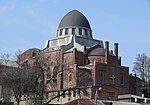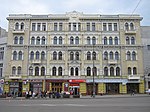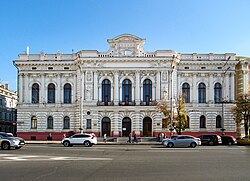Kharkiv Korolenko State Scientific Library
1886 establishments in UkraineAll pages needing cleanupBuildings and structures in KharkivCulture in KharkivEducation in Kharkiv ... and 2 more
Libraries in UkraineLibrary buildings completed in 1901

Kharkiv State Scientific Library of Vladimir Korolenko (Ukrainian: Kharkhiv'ska derzhavna naukova biblioteka im. V. G. Korolenka) – second by book fund after the Library of Vernadsky in Kyiv, Ukraine. There are 12 reading rooms for 524 places. Annually, to library comes up to 70 thousand documents (books, magazines, newspapers, databases and electronic documents on CD-ROM, etc.) An extensive system of reference – HDNB bibliography contains more than 60 directories and files including electronic, bibliography fund computerized database, printed catalogs and consolidated fund made references.
Excerpt from the Wikipedia article Kharkiv Korolenko State Scientific Library (License: CC BY-SA 3.0, Authors, Images).Kharkiv Korolenko State Scientific Library
Korolenka Street, Kharkiv
Geographical coordinates (GPS) Address Nearby Places Show on map
Geographical coordinates (GPS)
| Latitude | Longitude |
|---|---|
| N 49.990736111111 ° | E 36.23465 ° |
Address
Korolenka Street 8
61003 Kharkiv
Kharkiv Oblast, Ukraine
Open on Google Maps











